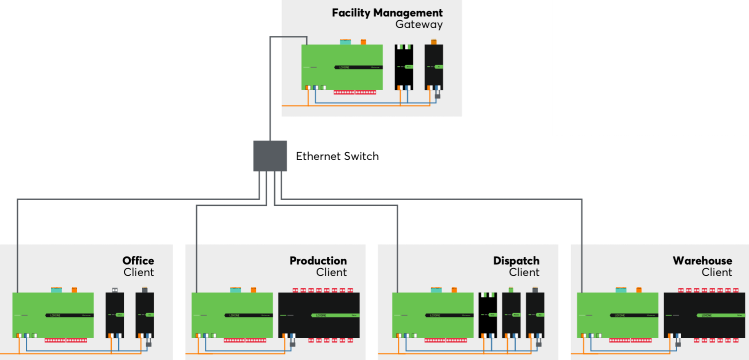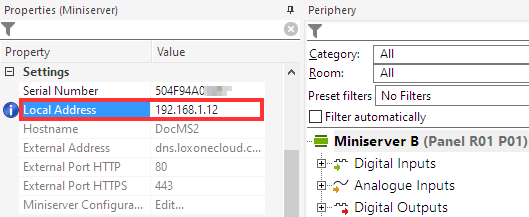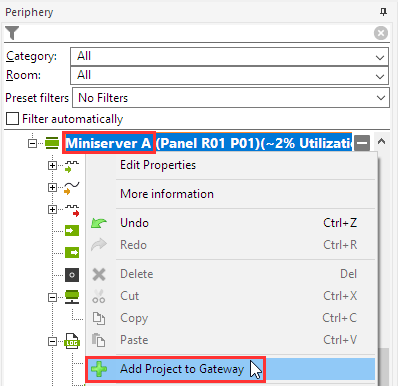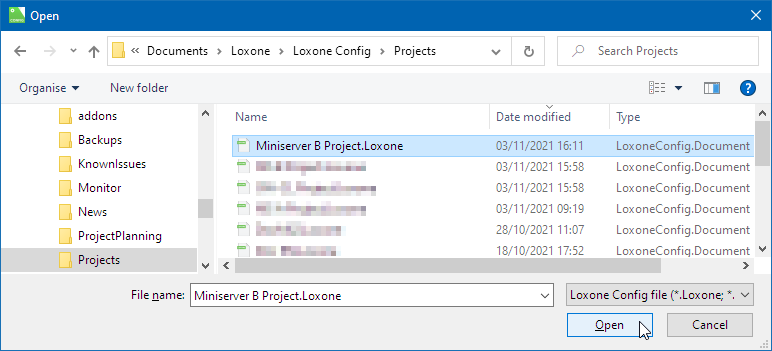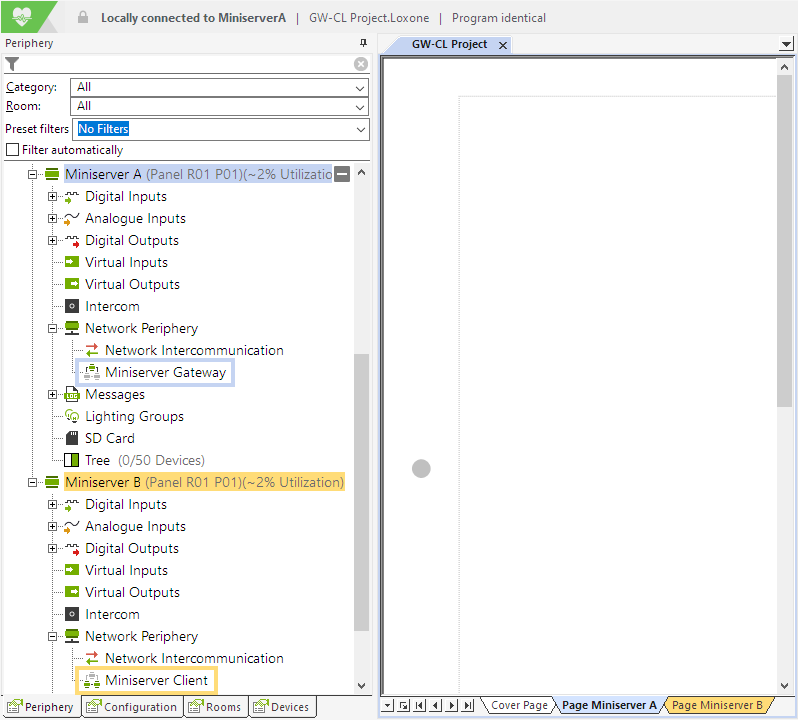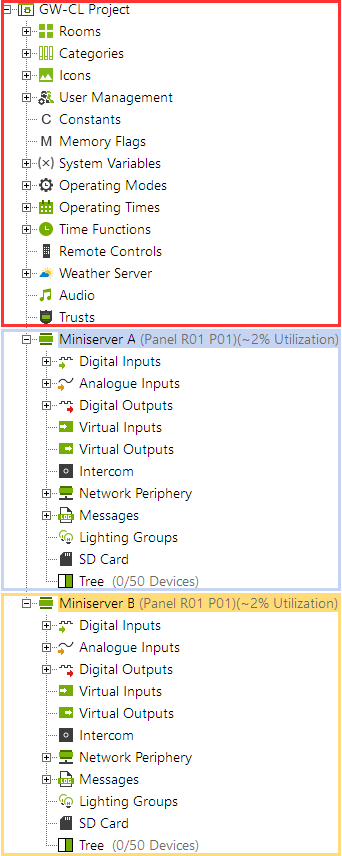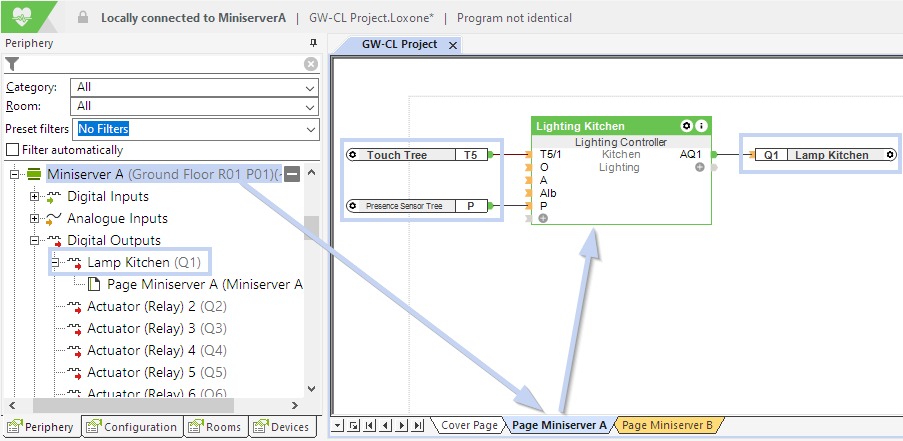The Concentrator function combines programming and also the user interface of the individual Miniservers.
CONTENT:
Application
Planning and preparation
Set up a Gateway-Client System
Programming
Application
Linking several Miniservers makes it possible to automate even large buildings.
At the same time, fail-safety can be increased because if one Miniserver fails, the remaining Miniservers continue to perform its service.
A Gateway-Client System can also be useful even in a single-family home.
Examples:
Gateway Miniserver on the first floor, Client Miniserver on the upper floor.
Gateway Miniserver in the main building, Client Miniserver in the annex.
In larger commercial buildings, the layout could look like this:
Gateway Miniserver in the technical room / main distribution,
a Client Miniserver each in parts of the building such as office, production, shipping, warehouse, etc.
Concentrator Function
The concentrator function combines both visualization and programming in one project.
This allows the programming of a project over several Miniserver, and is the simplest and for most applications most suitable form of a gateway client system.
If one does not use the concentrator function, all miniserver have their independent programming and visualization, but are also managed by one miniserver.
Application examples for this:
Hotel: One Miniserver Gateway for administration, one client Miniserver per room.
Residential buildings: One Miniserver Gateway for administration, one client Miniserver per apartment.
The same program is distributed to many clients, since many rooms are identical.
Different program types can also be defined depending on the type of room.
However, the size of the overall system is not limited to a gateway client system.
Since the miniserver can also exchange data using tree or network intercommunication, several Gatway client systems can also be networked together.
The individual gateway client systems remain largely independent of each other.
In larger buildings, for example, one gateway and several clients can be used per floor.
In this way, almost any building size can be automated.
Planning and preparation
The complexity of the overall system increases with its size.
Therefore, carefully considered planning and documentation of the overall system is important, and also facilitates maintenance.
Since the miniserver communicates via the local network, this becomes an important part of the overall system:
Ideally, one reserves an address range in the network for building automation devices, and also assigns static IP addresses in a logical order when configuring the Miniservers.
The Gateway Miniserver plays a very important role despite distribution to several Miniservers.
Through the Gateway runs both the programming of the entire system, the distribution of updates and program parts to the Clients, as well as access to the common user interface with the help of the concentrator function.
It is also important to take a structured approach to wiring. If a miniserver is to be used for a specific part of a building, the periphery of this part of the building, i.e. all sensors and actuators, should also be connected to this Miniserver.
With prudent programming, each building part will then be controlled largely independently by its own Miniserver, without being dependent on the other Miniserver.
In the following example we describe the setup of a new Gatweway client system.
We use the concentrator function to combine programming and visualization.
However, a gateway client system can also be set up later in the same way, e.g. when extending an installation.
Set up a Gateway-Client System
First we connect separately in Loxone Config to all miniserver that should participate in the Gateway Client System.
It is important to use the same user and password on all Miniservers.
Therefore, we leave the default login data admin/admin for the time being and change the password later, after the system has been set up.
We perform the initial setup of the Miniservers and assign static IP addresses. All Miniserver must be on the same subnet.
As local address in the Miniserver Settings of each project, the IP Address of the respective Miniserver has to be entered:
Afterwards we save the programs into the respective Miniserver, and save the projects also on the computer.
In Loxone Config we connect from now on only to the Miniserver which should take over the role of the Gateway.
In the periphery tree we right click on the miniserver and select “Add a project as a client” in the context menu:
Then we select the previously saved project of another Miniserver:
After that, a message will be displayed indicating the peculiarities of merging the projects. We confirm with OK.
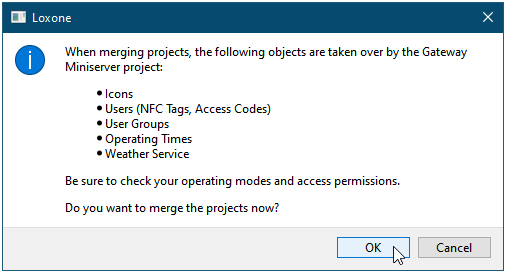
The selected project will now be merged in Loxone Config with the project of the already opened Miniserver. This is automatically created as a gateway.
In the same way, further projects can be added to the gateway as clients.
The merged project must now be saved in the gateway miniserver.
When saving the first time into the gateway, we get an error message, because the gateway does not know the new clients yet. We confirm this with OK.
The next window explains the saving process, we also confirm this with OK.
The gateway now restarts, then it distributes the program parts of the merged project to the clients.
Finally we save the merged project under a new name on the computer.
Programming
Let’s see in detail how a gateway client project with concentrator is displayed in Loxone Config.
All Miniserver are displayed together with their periphery in one project.
Each miniserver is also assigned program pages in the same color:
Next, we will use a simple example to program the lighting in two rooms.
Miniserver A and the kitchen are on the first floor.
Miniserver B and the bedroom are on the second floor.
Sensors and actuators of the two rooms are therefore connected to different miniserver.
We now insert the light control for the kitchen on the program page of Miniserver A:
In the case of the bedroom, on the other hand, we use a Miniserver B program page:
Now, when the lighting in a room is switched on by button press or movement, only the associated miniserver is involved.
Of course, functions can also be programmed across miniserver boundaries, and many central functions cannot be solved in any other way.
Where possible, however, the detour via other miniserver should be avoided.
When using the concentrator function and efficient programming, the following number of miniserver is supported:
| Gateway | Clients | Total |
| Miniserver | Up to 9 Miniserver or Miniserver Gen. 1 | 10 |
| Miniserver Gen. 1 | Up to 4 Miniserver Gen.1 | 5 |

